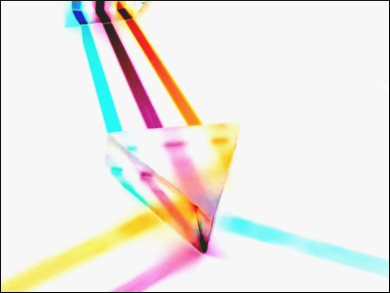What’s the Matter with Light?
Light and matter interact, that much is known. But how do photons affect a specific material, what will be its response, and how big that response? This is almost impossible to predict in advance. However, Rick Lytel, Mark G. Kuzyk, and colleagues, Washington State University, Pullman, USA, may have found a way.
The team has developed a heuristic approach that first involves throwing a metaphorical dart at the materials target and hoping, if not for a bullseye, then a high score. Once they have a hint of a powerful response, they can use computational methods to nudge their dart closer to the bullseye until they find a structure that will respond in the desired way.
The approach could be used in many disparate areas of science and engineering. For instance, it might be used to develop non-linear materials for higher-contrast medical imaging, to find more effective photosensitizers for cancer phototherapy, to improve astronomical photography by counteracting the twinkle of stars seen through the telescope, and even to boost optical communications devices to improve data transmission speed and reduce errors.
Non-Linear Optical Materials
Light interacts with non-linear optical materials (NLOs) based on a microscopic response of the molecular constituents of the material to the excitation by the optical field. The responses of non-linear optical materials (NLOs) are expressed in terms of properties known as first (β) and second (γ) hyperpolarizabilities. Approximate upper limits for these properties were determined seventeen years ago [1].
Light shining through a sheet of glass, for example, behaves in a linear way: one frequency in, the same frequency out. In an NLO, however, the frequency can be shifted. For example, sufficiently bright infrared (IR) light shone through a quartz crystal will emerge partially shifted to green. This is a frequency-doubling effect, which can be very useful for telecommunications and many other applications.
Some NLOs behave as optical switches and have been used as protection from laser light. Here they instantaneously become wholly opaque when laser light of hazardous frequency hits them. The same switching might also be exploited in transistor-type devices that use photons rather than electrons to carry information.
Fundamentally, the researchers use patterns to re-calculate the limits on how light and matter might interact in a given material. Their approach to designer materials is based on so-called Monte Carlo simulations. Searching for novel materials which solve a particular scientific or engineering problem where no obvious candidate exists is difficult. Of course, developing a model of every possible material requires complex equations, which not only need supercomputers to solve, but also give outputs that can be difficult to interpret.
Finding Patterns
Lytel and his team have turned this approach on its head: Rather than modeling specific materials with an obtuse formalism, they are examining the equations themselves to look for patterns that hint at the largest parameters for a given property, confined by the physical laws that quantum systems must obey.
The patterns they have found so far reveal something fundamental about designing materials with a strong light-matter interaction, namely that the upper limit is almost a third lower than earlier calculations have suggested. This means that for chemists, materials scientists, and nanotechnologists to find better materials based on these equations, they must aim even higher for structures which photons can interact with and be modulated by.
Critically, there are no currently known materials that sit above this ceiling and so, as with the work of earlier decades on high-temperature superconductors and other classes of materials, there is a need to investigate novel and perhaps exotic combinations of elements in non-integer formulations.
Materials for Specific Applications
The team’s next step in assisting molecular architects will be to apply the same approach of searching for patterns in the equations generated by constrained random sampling to the investigation of the combined properties of a material needed for specific applications. Then, a path for getting to that product in practical terms in chemical and nanotech laboratories needs to be identified.
Mark G. Kuzyk describes the process as follows: “If chemists make molecules (typically organic molecules), we will dope them into polymers then draw them into optical fibers to make wave-guide devices,” He adds that, “For the nano structures, it depends: If the structures are small and can be doped into a polymer, we will do this. If not, then perhaps we can assemble layers on substrates. We anticipate structures to be made of metals such as silver or gold.” Finally, he told ChemViews Magazine, “In the near future, we plan on setting up an experiment capable of measuring a single nano-particle.”
- Exact Fundamental Limits of the First and Second Hyperpolarizabilities,
Rick Lytel, Sean Mossman, Ethan Crowell, Mark G. Kuzyk,
Phys. Rev. Lett. 2017.
DOI: 10.1103/PhysRevLett.119.073902
Reference
- [1] Physical Limits on Electronic Nonlinear Molecular Susceptibilities,
Mark G. Kuzyk,
Phys. Rev. Lett. 2000, 85, 1218–1221.
DOI: 10.1103/PhysRevLett.85.1218



